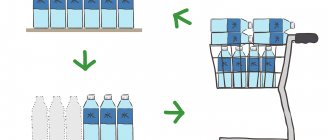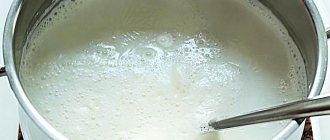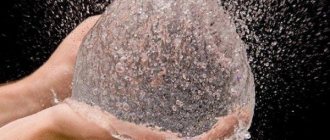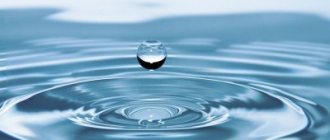Myths about why you can’t re-boil water in a kettle And yet, how many times can you boil a kettle?
The most unpleasant thing about raw water is bacteria, which can cause various diseases. Therefore, it is recommended to first filter the water to remove large contaminants and impurities, and then boil it. But how many times can you boil water in a kettle without it being harmful to your health? We find out in this article.
Why can't you boil water many times?
Water is beneficial to humans, because without it, all the cells of the body will die. It is important to consume fluid regularly, at least a liter per day. After drinking even a glass of water, the following happens:
- normalization of body temperature;
- restoration of intestinal functions;
- removal of toxins and waste from the liver and kidneys;
- dissolution of nutrients entering the body with food;
- joint lubrication;
- active metabolic process;
- stimulation of the elimination of pathogenic microorganisms.
When boiling, part of the liquid evaporates, and heavy metal salts settle on the walls of the container. Heating to 100 degrees several times causes light hydrogen to evaporate, while heavy hydrogen remains.
After the first boiling, the water partially turns from living to dead. If you boil it again, the beneficial qualities of such a liquid turn into complete harm. Consuming this type of water over and over again can lead to health problems.
Chemical characteristics of drinking water
Since our school years, we have all been familiar with the usual chemical formula of water - H20.
In simple terms, for every 1 molecule of water there is 1 oxygen atom and 2 hydrogen atoms. By the way, water that is healthy for consumption is absolutely transparent and should have no taste or smell. All types of water, whether tap or natural, contain a huge amount of mineral impurities that pose a threat to the human body. If everyone is familiar with tap water, then natural water is divided into several types: spring, river and lake. In addition to chemical elements, such liquids contain their own microflora and microfauna.
The main task of boiling is considered to be the elimination of harmful elements and microorganisms, which, when heated, lose their harmful properties. Let us dwell in detail on three important points:
- Water that goes through a repeated purification cycle loses its organic components. The death of these substances inevitably leads to their decomposition. The water vapor released during boiling increases the concentration of minerals. Consequently, the liquid becomes more concentrated, and therefore more dangerous for the human body.
- According to the chemical formula H2O, water consists of hydrogen and oxygen atoms. Thus, with each subsequent boiling, hydrogen, as well as isotopes of tritium and deuterium, are not removed from the liquid during evaporation, but settle at the bottom. Thanks to this process, the density of water increases significantly, which can also adversely affect health.
- During boiling, scientists discovered a reaction in which active chlorine began to interact with organic residues and minerals, which ultimately led to the creation of new dioxins and carcinogens in water. Such a reaction is quite difficult to predict, since its result depends on the degree of water filtration at treatment plants.
What are the effects of repeated boiling?
The danger for humans is that with repeated boiling three or five times, the amount of liquid volume decreases. But the substances that make up the water remain. Their share is becoming larger. When water that has undergone purification is boiled for a long time, active chlorine remains in the liquid, causing harm to human health.
Scientists note that by boiling water again, you get:
- changes in the composition of the liquid;
- formation of heavy hydrogen, deuterium;
- increase in the mass of nitrates, arsenic, sodium fluoride;
- harmful organic chlorine compounds;
- high concentration of heavy metal salts;
- calcium salts that are dangerous to humans.
Scientific facts indicate that prolonged boiling leads to the fact that the number of chemical reactions of chlorine with mineral salts dissolved in water increases many times over. As a result, carcinogenic substances and dioxins are released into the liquid.
In terms of the degree of harmfulness, repeatedly boiled liquid is compared with distilled liquid. Water that has passed the stage of steam and condensed water changes its properties and is not recommended to drink. Healers use distilled water, but return it to its beneficial qualities through freezing. After melting, the liquid will change its properties, you can drink it and cook food from it.
It is known that boiled water becomes dangerous when heated several times to 100 degrees. It leads to developmental delays in children. The increased content of sodium fluoride in it inhibits the child’s psychomotor skills. And for an adult, frequent use of such liquid for drinking will cause great harm to the body. Poisoning will occur, which will become the basis of many serious diseases, including cancer. Calcium salts will begin to deposit in the kidneys, causing the formation of gallstones.
Boiling to purify and soften water
The benefit of boiling is that it destroys dangerous bacteria and makes the water softer. This is the easiest and most affordable way to cleanse at home. If you boil water for 15 minutes along with steam, harmful chemical compounds will go away. But along with these elements, the concentration of calcium and other useful minerals decreases. At the same time, bleach and non-volatile substances remain in the composition. In boiled water they turn into more dangerous carcinogens.
The longer and more you boil water, the more useful substances will be lost, the more useless it will become. In addition, after boiling, salt deposits and stains remain on the walls of the dishes, and scale forms. At the same time, the level of dangerous pollutants in the water is low enough that it will not cause serious harm to health.
If you use an electric kettle, it turns off quickly and the boiling time is short. Therefore, repeated or even repeated boiling will not be harmful. However, many experts still do not recommend repeating this procedure and consider it unnecessary. Let's figure out why you can't boil water twice.
Repeated boiling is dangerous: myth or truth?
A handful of doctors disagree with the opinion of the main group of scientists. Thus, endocrinologist Mikhail Bogomolov expresses the opinion that the changes that occur in water after repeated boiling should not be considered mortally dangerous.
To get a liter of dead water, says academician I.V. Petryanov-Sokolov, you need more than 2 thousand tons of liquid from the water supply. Water boiled several times causes much less harm to the body than smoking a cigarette or car exhaust fumes.
But it is still advised to boil once rather than repeatedly. After the first boiling, all pathogenic microorganisms die. Tea is brewed with boiling water.
Do not dilute a hot drink with cold tap water, as this will lead to intestinal problems. When boiling, it is not recommended to dilute cold water in a kettle with hot water.
How to purify tap water
To get high-quality, healthy and tasty water, it is enough to settle the contents before use. Half an hour is enough for the harmful chlorine to disappear. Before boiling, it is better to stand for several hours so that harmful gases and compounds evaporate. If you pour the contents into a thermos, leave it open for a few minutes and only then close the lid.
For each boil, it is healthier and safer to use new, fresh water. Do not boil the liquid again and do not add fresh water to the water that remains after the previous boiling. To make tea or coffee, boiled water can be slightly heated without bringing the liquid to a boil again. Do not do this in the microwave as it kills all the beneficial elements.
To purify the water as much as possible, use special filters or products. For more information on how and how to purify tap water for drinking, see the link.
Is a microwave suitable for heating water?
Modern microwave ovens are suitable for boiling water. But the peculiarity of the process is that bubbles on the surface, even when reaching 100 degrees, will not appear like in a teapot. You can see that the liquid has boiled if you slightly move the container or lower a spoon into it.
Boiling in the microwave is dangerous
But you need to know that boiling in the microwave is dangerous. If the liquid overheats, the cookware may rupture. This will damage the microwave oven and may result in burns.
For proper boiling in the microwave you should:
- filling a clean container with water more than halfway:
- by placing a wooden sushi stick or spoon (not metal!) into the glass;
- turning on the oven to the desired mode.
You should stop heating every minute, stirring with a spoon, then turn it on.
A glass for boiling in the microwave choose one that is made of glass or ceramic. It is best to take a vessel for boiling water with cracks or chips inside. Bubbles will definitely appear when boiling in such a container.
As soon as the water boils, which takes about 3 minutes, turn off the oven and wait a minute. Only then do they take out a glass of boiling water, after tapping it lightly on the sides with a wooden spoon. Excess gases will leave the liquid, and it will not pour out of the container.
It is forbidden to cook in a microwave oven in metal utensils, as the device will stop functioning.
It is recommended not to lower the tea bag when heating it in the microwave. Tea bags often contain metal clips, which can cause sparks to appear inside the device and turn it off.
Remove the container with boiling water carefully, using a potholder or gloves. Do not bring the vessel close to the face so as not to burn the skin.
It is imperative to boil water for drinking. But there is no need to repeat the process several times. This will not bring any health benefits.
What happens during boiling
The boiling process involves bringing a liquid to a temperature of one hundred degrees Celsius, at which the evaporation process starts and the composition undergoes changes.
Initially, it is worth saying that boiling is a process in which the present pathogenic microorganisms and bacteria die, if they are present.
But against the background of the detrimental effect on the pathogens of the disease, other processes also occur that are difficult to classify as positive for humans:
- When boiling, water evaporates, which is reflected in the concentration of impurities and metal salts in the resulting liquid towards an increase.
- Chlorine under the influence of high temperatures enters into chemical reactions, which results in the appearance of dioxins, as well as carcinogens that can affect the cells of the human body, with the risk of developing diseases of complex etiology.
- Potassium and magnesium precipitate under the influence of temperatures, become insoluble, and are not absorbed by the human body.
- Sodium fluoride, which is part of the component composition of tap water, takes on a form that is dangerous to humans after boiling.
Naturally, all these negative characteristics, with proper boiling, single and short, cannot become critical for a person, since “undesirable” components accumulate in the body slowly. According to scientists, a visible negative “effect” from drinking such a liquid is possible only if you drink only boiled water every day for several decades in a row.
So what's wrong with re-boiled water then? Is it harmful or not to consume water that has been boiled again?
Don't boil - freeze
If you use boiling as a cleaning method, it is better to pay attention to a more effective method. The Internet is filled with articles that advise cleaning liquids by freezing them. And this option is suitable, even if you take chlorinated tap water. The most interesting thing is that this is not a myth; freezing really allows you to get rid of harmful impurities.
After the water turns to ice, there will be a small amount of liquid left at the bottom of the container that needs to be drained. As experts say, this is light water that is poorly absorbed by the body. Defrost the ice and drink cool water with pleasure. An excellent option for storing bottled liquids.
In conclusion, let us remind you: many diseases begin due to a lack of fluid in the body or its low quality. Remember that clean water without impurities is the basis for a person’s long life and good health.
Is distilled water good or bad?
Many "experts" in the field of water purification often advise using distilled liquid. It seems that its beneficial qualities do not disappear even after several boilings. But is it?
We recommend: Magic, no less. How to thread a needle in 1 second
Distilled water, having gone through the stages of evaporation, cooling and condensation, receives simultaneous saturation with oxygen and carbon dioxide (as well as a number of other substances). As the level of carbon dioxide in a liquid increases, the aquatic environment becomes slightly acidic. If distillation is carried out several times, the water will become completely neutral (this is used for technical purposes, for example, for refilling batteries).
Reasons why you should not drink distilled water:
- Its pH is several units lower, which negatively affects metabolism.
- It does not dissolve the minerals that are needed for normal nerve conduction, to renew body tissues and maintain hormonal levels.
Is distilled water harmful or beneficial? It is definitely harmful, because if a person often drinks distilled water, he does not receive minerals in the required quantities, so he first develops kidney disease, and subsequently other pathologies.
How to reduce harm and increase benefits?
If you don’t have healthier water at hand, you can resort to simple techniques that minimize the harm of boiling:
Follow the recommended boiling time - no more than 10 minutes, so that all the oxygen does not have time to evaporate.- Boil a small amount of water at a time so that it does not have to be stored and reheated for a long time.
- Pre-settle and/or freeze the water.
In the first case, it is simply poured into a container and left for 10-12 hours, waiting for a grayish-white flaky sediment to form. These are the most harmful compounds. The settled water should be placed in the freezer and wait until it freezes almost completely, only a small “cavity” remains inside. The ice is broken and what remains liquid is drained. - Regularly descale the kettle and wash the container in which boiled water is stored.
- If you plan to pour water into a thermos, do not close it immediately, let it stand for 10-15 minutes.











